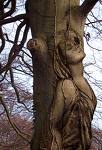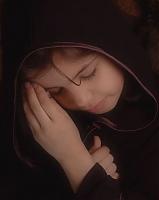Lines 1-2
I found a dimpled spider, fat and white,
On a white heal-all, holding up a moth
- We've said it before: Frost is a sneaky dude. At the start of the poem, he is trying to sound like he's got nothing up his sleeve.
- These first two lines sound like a children's poem.
- The word that sticks out to us is "dimpled." Frost gives us a spider, which is supposed to be creepy and scary, but he makes it fat and dimpled, turning it into some kind of cartoon spider. It's like the spider in "Little Miss Muffet," or maybe the Itsy-Bitsy Spider's obese cousin.
- The bouncing rhythm of the line also makes it sound childish. The poem is written in iambic pentameter, which means each line has ten syllables that alternate between unstressed and stressed syllables: daDUM, daDUM, daDUM, daDUM, daDUM. (Check out "Form and Meter" for more on that.)
- Even though the line is so childish, Frost is already slipping in a sneaky, scary tone. This spider might sound at first like a sweet cartoony spider, but look closer. Spiders aren't supposed to be dimpled; they aren't supposed to be fat. And they sure as heck aren't supposed to be white. This spider is actually some bloated, freaky arachnid like Shelob from Lord of the Rings. So what seemed innocent at first is actually pretty terrifying if you think about it. And that's just line one.
- The second line brings even more irony. Frost gives us a pretty little flower called a heal-all. Normally, it looks like this. In the poem, though, it's not blue—it's white. Not what we expected, is it? But wait, there's more. The flower is called a "heal-all." Its name comes from a widespread belief that the flower had medicinal properties. So it's a pretty little flower that makes everything better. There's only one little problem with that picture. On that pretty little healing flower is a sickeningly fat and white spider "holding up a moth" and about to eat it alive. Now that's ironic.
- You probably saw the word "white" repeated really close together in lines one and two. This repetition reminds us what a crazy coincidence all this is. The poem becomes one of those stories that starts out: "Check this out—the craaaziest thing…" It's not just that a spider was somehow white, not just that this blue flower was somehow white. It's that the white spider just happened to be standing on the white flower. This is way too weird to be just a coincidence, right? Let's read on…
Lines 3-4
Like a white piece of rigid satin cloth--
Assorted characters of death and blight
- You'll never guess, but that moth from line two? Yeah, it's also white. We know, right? In this case, the moth is probably already dead, maybe from spider venom. We can guess that because it's "rigid."
- Even though "rigid" gives us a sense of dread, like a dead body in rigor mortis, that word "satin" stands out as smooth, even flexible. We've got more contrast here. For the sake of sounding like we know what we're talking about, let's agree to call that phrase "rigid satin" an example of juxtaposition.
- Lines 2 and 3 move us away from the spider and toward the moth. This gets emphasized by the rhyme scheme, which rhymes "moth" and "cloth." (Line 4, meanwhile, creates an end rhyme with line 1: "white" and "blight.")
- Line four also sounds like a really depressing family reunion—"assorted characters of death and blight." Particularly weird is the phrase "assorted characters." It makes this feel like a scene or like a joke—as in, "A spider, a flower and a moth walk into a bar…" It feels like it's a scene that has been pre-arranged, like we've rounded up a few usual suspects. And that's just what Frost wants us to think. This does seem like a set-up. This does seem like a collection of "characters" who are acting in some drama.
- All of these "characters" are associated with "death and blight." The spider is the killer, the moth is the killed, and the flower is the murder scene. All three are blighted, or ruined, in their own way. The spider is bloated and dimpled, both the spider and the flower are a sickly white rather than their usual colors, and the moth is pictured as if it were some sort of funeral linen. We are shown a very natural scene that appears to us to be very unnatural. What's the scoop? Let's read on…
Lines 5-6
Mixed ready to begin the morning right,
Like the ingredients of a witches' broth—
- Just when you think you've got ol' Frost figured out, he pulls out a new trick. When you zig, he zags. We start line 5 with a verb that immediately changes our perception from line 4. There we had "assorted characters," these three individual entities that happened to be in the same place at the same time. But now he says they are "mixed." What are we doing here, baking a cake? Frost is pushing us to see these separate units—spider, flower, moth—as one thing. Each one has been bound to the other by these unique and pre-determined circumstances.
- The language of line 5 continues to emphasize that the scene is all set. They are "ready to begin." It's like we are watching right before the curtain goes up.
- Anyone else think that we've heard line five before on a coffee commercial? Just us? Fine. But it does sound awfully chipper considering these are images of "death and blight."
- Not to worry, though, because Frost's next metaphor is going to sling us right back to a negative image. The "witches' broth" is an allusion to the three witches in Macbeth. You can read all you could ever want to know about the play here, but it's important to know a little bit now. In Shakespeare's play, the witches (who mix a brew using some crazy ingredients) predict the future of the main character. The head scratcher for Macbeth is this: are these predictions simply knowledge of what will happen, or does that knowledge mean that there is some power controlling what happens to all of us? And that's exactly what Frost is talking about here with all these white things. Did they just show up by coincidence, or is there something out there orchestrating these events? Hmm.
- Now, Shmoopers, a lot of students are prone to doubting poets. If we had a nickel for every time some kid said, "The poet didn't really mean to do that—you're just making that up," well… let's just say we'd have a lot of nickels. So you might be doubting that Frost meant to allude to a Shakespeare play which just happened to be about the exact same theme. He was probably just talking about any sort of potion. Right? Nope. Wrong. Thanks for playing. Look at the apostrophe. If he was simply talking about a brew a witch whipped up, it would be a "witch's broth." But it isn't—it's "a witches' broth," meaning a broth made by multiple witches. Like the three witches in Macbeth. We rest our case.
Lines 7-8
A snow-drop spider, a flower like a froth,
And dead wings carried like a paper kite.
- So, time for a quick recap: line 4 was really dark, line 5 was really light, line 6 was really dark again—anyone want to take a shot in the dark about the tone of line 7? Yup, we're back to rainbows and puppy dogs. Alright, so maybe it's not rainbows or puppies, but snow-drops and frothy flowers. That still sounds like a few of our favorite things.
- Now, say "snow-drop spider" seven times. Go ahead, we can wait. It's not like we've got a date or anything. Finished? Wasn't it fun? Kind of fun? Fine—mildly interesting? We'll cover all the sound effects in the "Sound Check" section, but for now it's worth taking a second to appreciate that there are three different consonants that repeat in these two words. It sounds so cute!
- And the image itself is cute—a snow-drop sounds like something out of CandyLand. Then you remember: "Oh wait, we are talking about a killer, obese, albino spider." If you're keeping score at home, this is another example of irony.
- The "flower like a froth" is a similar image. With this description, we've got some alliteration, while the image of froth—especially combined with the snow-drop—gives us a light, fluffy picture. But there's a dark side to this one, as "froth" could easily be seen as someone or something foaming at the mouth after being poisoned (as in, oh we don't know… poisoned by a spider).
- By the time we get to line 8, we are back to darker ideas. We've got "dead wings." The idea that it is like a kite would sound a little more hopeful, except that we are told it's not a flying kite. It's being "carried."
- It might be worth mentioning here that most poets have lots of different ways of making metaphors. They find bizarre and creative ways to say that X and Y are somehow related. But Frost has really only used one method in this poem and he's done it four times. That's weird. Instead of traditional metaphors, he uses "like" to create a simile. Similes are weaker forms of comparison. They suggest that two things are like one another without saying one thing is another. I mean, what if Pat Benatar had said "Love is like a battlefield" instead? Frost is just doing what he's been doing to us the whole way through the poem—not letting us get comfortable with a straightforward interpretation. Things are light and then dark; things are fated but accidental; things are similar to each other, but also different
Lines 9-10
What had that flower to do with being white,
The wayside blue and innocent heal-all?
- We've hit that ever-important part of a sonnet called a "turn." It's not too hard to catch in this poem, because there is a stanza break, but you could've called it as soon as you saw the rhyme scheme. We'll go over all this later, but this is a Petrarchan sonnet, which is usually broken into an eight line chunk (called an "octave") and a six line chunk (called a "sestet").
- So what's the shift here? Well, it's pretty obvious, actually. We go from observing the scene with the spider, flower, and moth to wondering about and reflecting on said spider, flower, and moth. So, in these two lines, we get our first question. The speaker wonders what led the flower to be white.
- One more note about line nine. The rhyme scheme so far has been ABBAABBA, but we usually expect a change in that pattern when we hit beginning of the sestet in line nine. That's not happening here, though. Here we get a repeat of that 'A' rhyme. Frost limits his rhyme sounds in the poem to emphasize its formality, its design. Hmm—why does that word sound familiar? He's telling us through these rhymes that he (the godlike poet) is controlling every little detail of his work. (Check out more on this over in "Form and Meter.")
- Line 10 makes things a little murky. The speaker just told us again that this flower is white, and now he tells us it is blue. Well, he probably shifts from talking about this particular flower in line 9 to talking about all heal-all flowers in general. It's kind of like that old Humphrey Bogart line from Casablanca: "of all the heal-alls in all the world, why does this one have to be white?"
- The adjectives "wayside" and "innocent" emphasize this same idea that the flower didn't do anything to make itself white. It's just a heal-all—it's supposed to be blue like all the others, but it isn't. The speaker is proclaiming the heal-all not guilty of turning itself white. So the question remains: who is responsible?
Lines 11-12
What brought the kindred spider to that height,
Then steered the white moth thither in the night?
- More "-ight" rhymes? It's really getting to be an obsession with this guy. Once again, though, he is showing us the very tight hold that he as a creator has on his creation.
- This second question, which moves from the flower to the spider and the moth, begins to get to the heart of the matter. The previous question was all about the connection and meaning of the coincidence. Why was that particular flower white? Why was it right there at that certain time? But there could be many simple answers to that question. Now we get more complicated.
- Now we are asking "what brought" these characters together. The verb "brought" (and "steered") imply that someone or something must be responsible for this moth massacre.
- Frost is still being nice and ironic. He wants to remind us that the spider (like the flower) is bizarrely white, but he doesn't say it. We know it's not because he has a problem with the word "white"; he's already used that lots of times. No, he says that the spider is a "kindred" spirit with the flower. This disgusting spider that is about to devour the moth is connected, related even, to the pretty flower.
- The rhyme in line 11 allows us to picture the perspective of the spider. Sitting on top of the flower, the spider was far above the world below ("to that height"). By describing this scene as an elevated place, the poem begins to take on a mythic, epic tone.
- We are given another new picture in line 12. We learned earlier in the poem that this group was "ready to begin the morning right," but we didn't really process what that means. Here we find out that it means that all the craziness went down during the night. During the night, the moth blindly ended up on the flower and was caught by the spider. Now, as the sun rises, the spider is poised to enjoy his hard-earned meal. When we picture this happening at night, we see even more clearly that some supernatural force must have arranged this event—none of the participants could see where they were headed.
- "Thither" is a funny word. It kind of sticks out in this poem. It means "to or toward a certain place," as opposed to "there" which means "at a certain place." It's a small difference and we can probably chalk most of it up to Frost needing to fit his meter, but we could also say that "thither" means that the "steering" was a process—at every step, some force was drawing that moth slowly toward the flower and the spider and, well, toward death.
Lines 13-14
What but design of darkness to appall?--
If design govern in a thing so small.
- Frost has a few more tricks saved for us here at the end. The first is the form. We expected this to be a Petrarchan sonnet, which has its turn at line 9 and then begins its resolution. Instead, that's when all the questions start. Then he throws a rhyming couplet at us here at the end, which makes the poem look like a Shakespearean sonnet. We get a second "turn" here, when most sonnets just have the one.
- The second turn starts with an answer to the questions, but in the form of another question. The rhetorical question here says in essence: What made all these white things converge on the same point at the same time? What could have except some sort of evil Designer? In other words, Frost thinks that this whole thing is way too creepy to be coincidence and so it must be some sort of design.
- It's not just some sort of design though—a "design of darkness." The alliteration emphasizes the bad intentions of such a creator. He's right to say we should be appalled. How else are we supposed to think? Some divine force went out of its way to gather up three totally rare living things and then put them together for some kind of horror show.
- That the designer would be associated with "darkness" adds a little more irony for us as readers, because we've seen the word "white" used five times already. This contrasting imagery leaves us with darkness after all that light.
- The word "appall" can be seen as a pun on the words "a pall," which is the cloth that's spread over a coffin. This designer is death-hungry.
- Punctuation is always fun, isn't it? There's nothing like a good semicolon (if you ask us, anyway). Frost is having a little fun of his own here at the end. We've got that last rhetorical question and it feels like the end of the poem, but then here comes that dash to make us feel a little more suspense before we make it to the last line.
- The final line of the poem complicates the answer the speaker just gave us. Line 13 leaves us appalled at some god who seems more like some mean kindergartner who goes out of his way to pull the wings off of butterflies. It makes us more than a little bit afraid to go on living in such a universe. Line 14 tries (but fails) to cheer us up. Basically, he says: "Look at the bright side: maybe nothing controls our actions and everything that happens to us is completely random." Sheesh. Are we supposed to feel better about that? Yeah, probably not. So we are left at the end of the poem with a healthy sense of ambiguity, of mixed emotions about the possible workings of the universe.










